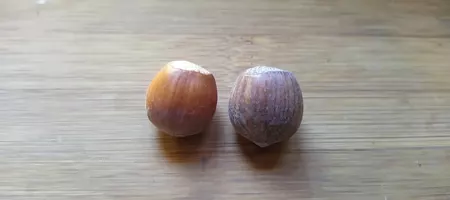Hazelnut bushes are lovely deciduous shrubs that are indigenous to Europe and Asia. They are part of the Corylus genus and can grow anywhere from 1.8 to 10 meters in height, depending on the type. These speedy growers usually have a lifespan of 20 to 40 years.
Their yellow catkins (flowers), circular or oval-shaped leaves, and delectable nuts encased in a husk that divides upon maturation are all characteristics of these bushes. The nuts are widely used as food, while the wood is employed in making furniture and baskets. Hazelnut bushes thrive in moderate weather and well-drained soil, and are commonly cultivated in Turkey, Italy, and the United States.
Benefits and usage
Hazelnuts are a good source of protein, healthy fats, and various vitamins and minerals, including vitamin E, magnesium, and potassium. They are also a popular ingredient in many sweet and savoury dishes, such as chocolate spread, cakes, and roasted and salted snacks. They are also used to make oil, which is used in cooking and cosmetics.
Hazelnut bushes in Finland
The obvious questions would be: do Hazelnut bushes grow in Finland. My answer is: depends. I have seen big bushes / trees in the south of Finland but I have seen none above Tampere. Doesn’t mean that there aren’t any. From my perspective it depends on the Finnish climate zone. Here at Beyond Buckthorns we are at zone 2, while for example Helsinki is Zone 1. Most cultivars will tolerate -20°C, which we get in zone 2, but probably won’t survive more than -35°C. But I have no data about it. Since some of the nurseries are selling hazelnut cultivars and the common sense is that hazelnuts will grow in Finland, there should be no doubt about at least trying it out.
Finding the right spot for hazelnut trees
Slope or not slope?
On our path of observation I came across several spots where I thought hazelnuts can be placed. During a visit in Karjalohja Joel Rosenberg told me that nuts prefer a slope. From my years of observation in Germany, where there a so many hazel- and walnut trees, I couldn’t confirm his findings. Actually a lot of high yielding trees are on a plain surface and even within big cities. There are often stand alone trees which have no companion and those trees fruit very well. I brought hundreds of nuts from different varieties with me.
It may indeed not be about the slope but about the well drained soil. Most of the time a slope is automatically drained because the water flows down by gravity. Hazelnuts grow best in well-drained soil. They prefer soils that are fertile and moist, but not waterlogged – little bit like sea buckthorns. Hazelnuts are not very tolerant of drought and are susceptible to root rot if the soil is too wet.
Loving the sun
At Beyond Buckthorns we have a lot of edges due to the shape of our forest (see the map). Some edges are even south facing and by that yield a high amount of sun hours. Hazelnuts need a moderate amount of sunlight and can grow in partial shade, but will produce fewer nuts.
Possible permaculture Zones
Hazels don’t need a lot of attention. There are entire forest of native hazelnut trees existing in Finland. They just grow.
Hazelnuts benefit from regular pruning to maintain shape and remove dead or diseased wood. They are also susceptible to a number of pests and diseases, for example the nut weevil. It is therefor important to monitor the trees regularly and take appropriate action if any issues arise.
Hazelnut trees more or less fall into the category of Zone 2 to 4. I don’t have to spend a lot of time there. Probably only in the first year nervously checking on my precious hazels.
I could place some nice hazel somewhere around the main garden at Zone 2, while the majority could go on the edge of the forest, mainly Zone 3 and 4.
Selecting hazelnut tree cultivars / varieties
In Finland there are several cultivars available. There are even some cultivar trials around in Finland. I yet haven’t had the time to look closer into them.
What I usually do is:
- I go to Germany, find a high yielding hazelnut tree and then collect the nuts – lots of them – and then plant them, either right on the final destination or in a bucket.
- I also buy young 1-3 year old saplings from different nurseries.
- From time to time I also exchange saplings with other permaculture homesteads.
Variety is key – and also the marginal. I haven't gone into grafting yet.
Hazelnuts at Beyond Buckthorns
At Beyond Buckthorns we mainly have
| Name | Amount | Zone |
| Corylus avellana | 3 | Zone 4 |
| Corylus avellana | 4 | Zone 2 |
| Corylus avellana – Hallesche Riesennus | 2 | Zone 2 |
| Corylus maxima | 1 | Zone 2 |
| Corylus colurna (Haselnut tree) | 2 | Zone 3 |
And of course we planted a lot of nuts from trees we didn’t fully know what cultivar they were. I guess that over the next 10 years we will have more than hundred plants all over our place.





